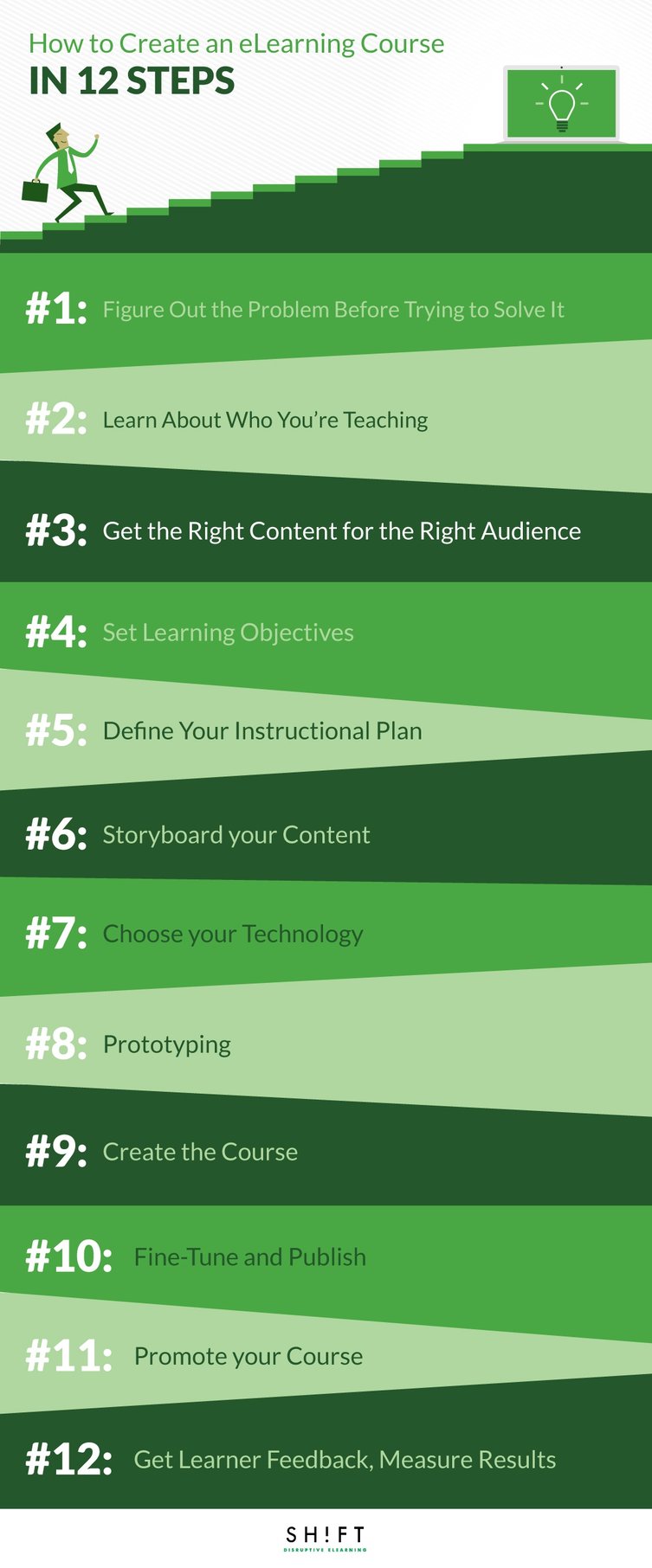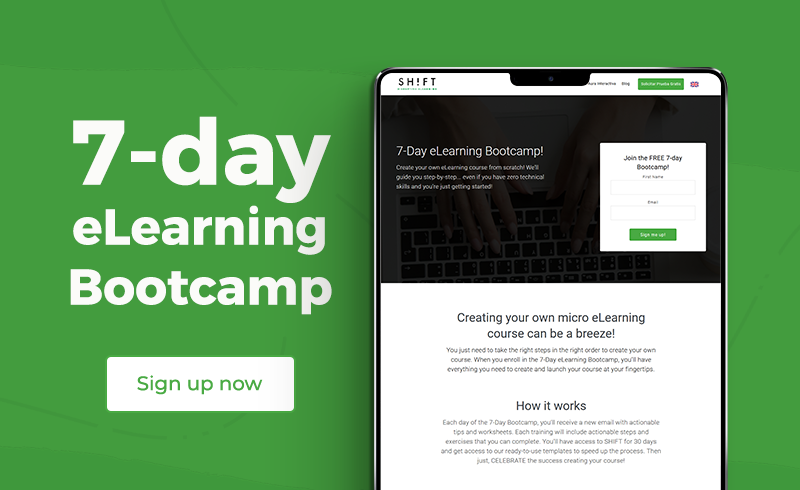How To Set Up An E Learning Centre
Looking at all the things that are involved in creating an eLearning course could make you feel like your outset pace should be to "Give Up." However, with these 12 steps, we break down the process into manageable chunks, which is a big part of what makes for good eLearning grade blueprint. Non and then bad, right? Read through these steps, and presently you'll have a skilful handle on what is needed and where to get-go to create your first eLearning courses. Contrary to popular belief, deciding "we demand eLearning because anybody else is doing information technology" is not really the first step to start. Managers add to this problem by expecting things to merely get done, or to "only practise it." Many times, they run into assessing needs before implementing as a waste of time and value speed in development over all else. Starting an eLearning course based on assumptions is a sure way to neglect though. The first step to creating an eLearning class is, in fact, defining why does your audience need this training? And what information technology is you want to achieve with this eLearning because otherwise, how volition you know if you lot've reached your goal? A demand analysis make sure you aren't doing training just for training's sake. Conducting a needs assay: This analysis can range from a simple interview to broader, more in-depth information collection methods that include looking at past training, desired results and the electric current state of your workforce. The results of this assay get your plan for blueprint and what you promise to become your learners to achieve because now you know what they actually need, versus only guessing or bold. It volition as well bear witness gaps in current training and how yous can close the breach and go results. This also prevents y'all from throwing eLearning at a problem it can't solve. Elearning is perfect for addressing gaps in skill or knowledge merely is typically not an effective cure for lack of customer satisfaction or a job blueprint problem. Past analyzing commencement, y'all rule out these other problems and get to the middle of the trouble faster than if you have gone on assumption. Read:DON'T Skip the Training Needs Analysis! Here's Why. Brand sure, yous've inquire yourself these questions before standing to the adjacent step: Writing a class entirely in Spanish to a group of people just showtime to larn Spanish is not an constructive way to teach. This might sound like an extreme case of an eLearning designer not knowing their audience, but consider the fact that this is really no unlike than teaching a kickoff javascript course but including avant-garde terms with no caption of them. Designers often get into a project treating their audience with a ane-size-fits-all approach in order to go the information out quickly. This, even so, ignores your audience's technical capabilities, existing noesis, how they will use the cognition yous're giving them and their basic demographics. If a business has low interest in their training programs from employees, it is oft the case that the courses are too difficult or too like shooting fish in a barrel or completely irrelevant to the employees' jobs. By knowing your audience first and learning what they already know and need to know you can create ameliorate, more useful content. Also Read: Once you lot've determinedwhy training is needed andwho your audition is, information technology'southward time to analyze your content. It won't affair how expert your course is designed if the content your sharing doesn't have value for your audition. This is why this step is and so important. You have to take the trouble you defined in bespeak #i and find information that addresses information technology specifically. To exercise this, nosotros analyze the content and break it down into categories and types: Starting out on your eLearning journey without defining the information or skills that you want your learners to obtain past the end is like setting out on a road trip without a destination. While this might make for a neat setup for an indie film about iv friends trying to find themselves, this really doesn't work for eLearning. So, what is a learning objective? It is an expected outcome of each lesson/unit and, overall, what you want your learners to exist capable of by the stop of the it. They also break downwardly the content from step #3 into more manageable chunks that tin exist applied to modules within the overall class. During this footstep nosotros, every bit designers, have the chore of asking questions and because both the desirable and undesirable results of the form. Then we write our objectives based on the final desired results. Start past picking three-four objectives. At present make sure your content doesn't wander too far away from these objectives. Creating relevant learning objectives can be a large challenge, and before we have the claiming we have to make sure these are fix under the SMART criteria: Note: Make certain learning objectives are aligned to business objectives As well read: D o's and Don'ts for writing learning objectives At present is the time to decide on your instructional strategy. This strategy is the procedure or arroyo by which your course is going to be developed to engage learners. There are a diversity of approaches eLearning designers tin can take including storytelling, discovery learning, situational learning and several others. This infographic guide is a great tool to acquire about the primary instructional strategies:Instructional Strategy Infographic When deciding on a strategy, think virtually: Acquire the differences between strategies and models here: Models Vs. Strategies Infographic A storyboard is a crude, visual outline that helps map out how text, pictures, and other elements will look on a page. This volition help yous encounter how your page will look before you waste time putting together the final design just to find out the elements don't fit together right. However, earlier you showtime in on the design phase, make certain your content has been approved. At that place's no reason to include content in your planning if your client or team leaders might end up telling you lot not to utilize it. Download: Storyboard Template When determining what authoring tools and learning management systems you should use, expect at reviews from other designers, available features, cost and what is best for your system. There is not i tool that works for everybody. Needs vary from one company to another. Too, look at these aspects to get yourself thinking about what'south right for your company: Now, it's time to build a working, prototype of a module from your course to make sure it actually works. A image defines the representative expect-and-experience and functionality of the entire course. It besides is used to test out technical functionality. This allows eLearning designers to create and discard multiple versions quickly to get the all-time fit earlier wasting too many resources on designing the whole class so finding out something doesn't work. Note: Become approval of the paradigm from the project leader before going for the whole grade. Read: Instructional Design for the Greater Good: Developing a Prototype One time y'all have your epitome approved, information technology'south time to start designing the actual form. During this process you demand to go along an eye on the original objectives and issues to ensure the course, as a whole, is geared towards solving these. You as well need to determine a design method that meets the needs of learners. Professional eLearning designers use different models. Some of the well-nigh popular are: ADDIE/SAM, Gagne's 9 Principles, and Action Mapping among others. Learn the 4 Peak Instructional Models here . Applying Gagné's 9 Events Of Instruction In eLearning Take feedback and comments from your squad (and clients), brand corrections as needed, so publish! Why do your learners need your grade? How will they find it? You know that your course tin can help them, but now they need to know about it! It'due south time to promote and market. To do this, focus on the benefits to your learners to get them invested in the learning journey. Promotion should exist function of your development programme, and your very first slide should engage your audience from the start. Creating an internal promotion planvolition save y'all the heartache of creating an awesome course but to notice out nobody is taking it. Determine how effective your course has been by request your learners. This volition help you figure out what you lot did correct and what y'all tin improve on in the future. To determine if this has been achieved, many utilize Kirkpatrick's Iv Levels of Evaluation. Yous will also look at such factors as render on investment, toll, and performance. To get the best idea of your key performance indicators, you should involve the management squad and stakeholders. REFERENCES: http://world wide web.mylearningspace.com.au/news/six-steps-to-an-effective-learning-strategy/ http://www.fao.org/docrep/015/i2516e/i2516e.pdf http://www.tacso.org/doc/doc_manual9.pdf https://preparation.fws.gov/courses/references/chore-aids/trainers/HOWTO-create-online-grade.pdf http://www.fao.org/docrep/015/i2516e/i2516e.pdf

Footstep #1: Start with Why: Practise a Need Analysis
Step #2: Know Your Audience
Step #3: Content Assay: Create the Correct Content for the Correct Audience
Step #4: Learning Objectives
Step #5: Define Your Instructional Design Plan
Step #6: Storybrand Your Content
Stride #7: Choose Your Engineering
Step #8: Prototyping
Step #9: Create the Form

Step #10: Fine Tune and Publish
Step #eleven: Promote Your Course (Internally or Externally)
Step #12: Ensure Y'all Can Measure out and Evaluate Results

How To Set Up An E Learning Centre,
Source: https://www.shiftelearning.com/blog/how-to-create-an-elearning-course-steps
Posted by: irwinfauting.blogspot.com


0 Response to "How To Set Up An E Learning Centre"
Post a Comment